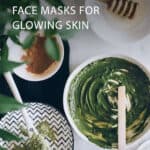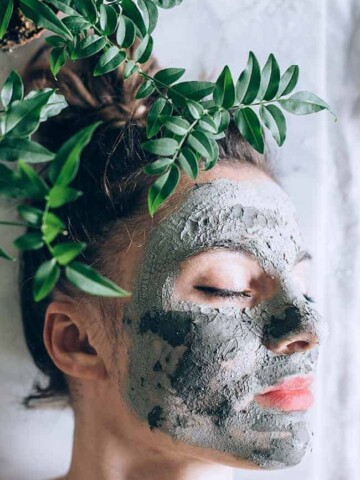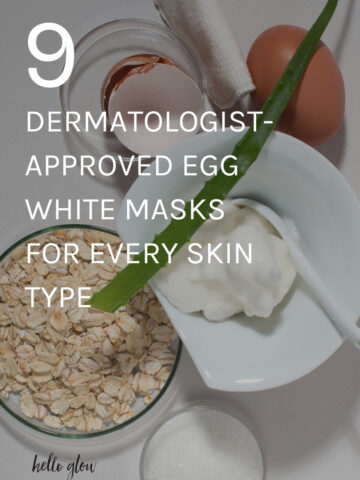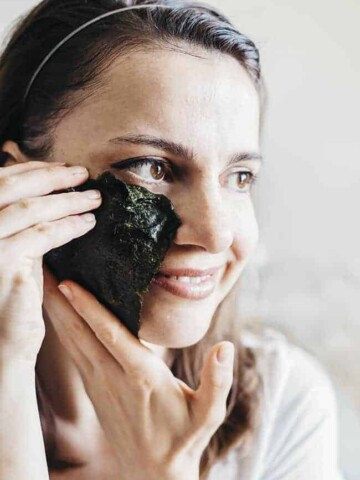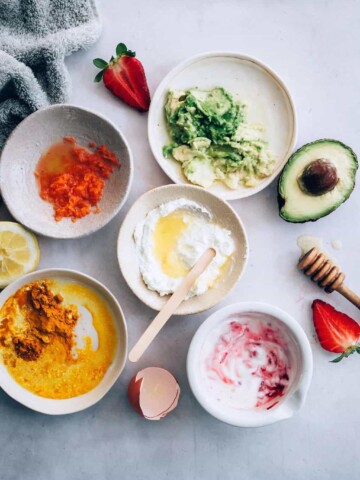Green tea is all-around awesome. It is seriously one of the best things to put on your face in summer. Its fancy-pants polyphenols help protect the skin from the sun, while the catechins go forth and fight aging and sun damage. Brew up a cup, then try these green tea face mask recipes to fight acne, puffiness, sagging, and age spots.
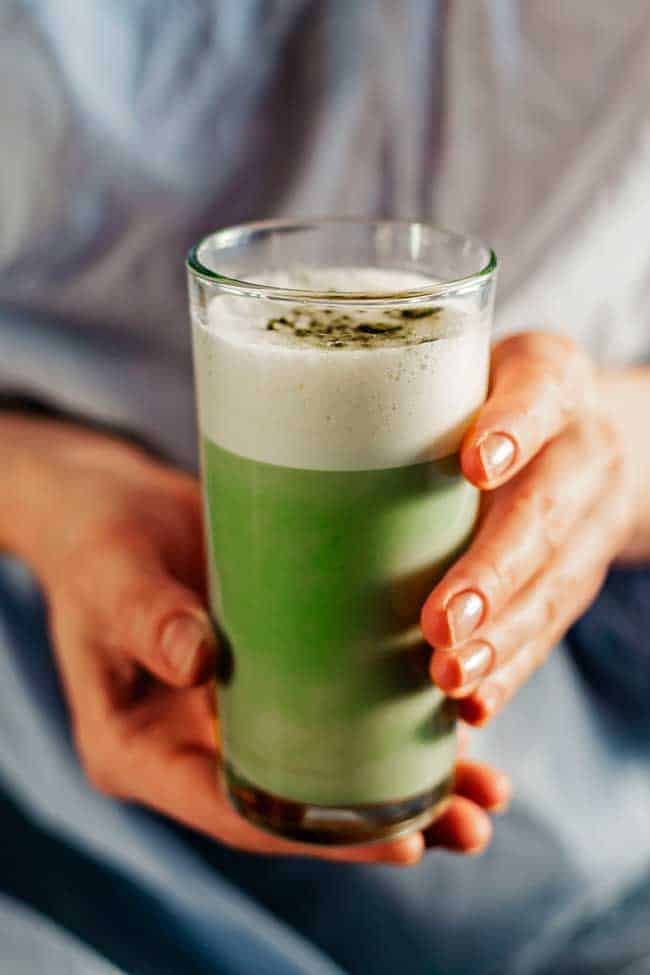
Using Geisha beauty secrets that date back centuries, these face masks will rejuvenate your skin with matcha, rice water, and green tea—without needing a drop of bird poo or any other unsavory traditional ingredients.
Yes, apparently, the Geishas used nightingale poo to exfoliate the skin [source], but I suspect it might hold the world record for being the worst-smelling beauty treatment of all time, so I'll just stick with green tea!
Jump to:
- Ingredients
- 1. Polishing Mask to Rejuvenate Dull Skin
- 2. Antioxidant Mask to Plump Wrinkles
- 3. Hydrating Mask for Dry Skin
- 4. Herbal Steam to Boost Radiance
- 5. Protection Mask to Prevent Sun Damage
- 6. Drawing Mask to Detox Skin
- 7. Energizing Mask to Shrink a Double Chin
- 8. Spot Treatment to Fight Acne
- 9. Mask to Even Out Skin Tone
- 10. Exfoliating Mask To Brighten Skin
- 11. Cooling Mask to Soothe Sunburn
- 12. Soothing Mask for Wind-Chapped Skin
- 13. Calming Mask for Itchy Skin
- 14. Ice Mask to Calm Sunburn
- 15. Healing Compress to Combat Redness
- Top tip
- FAQ
- References
Ingredients
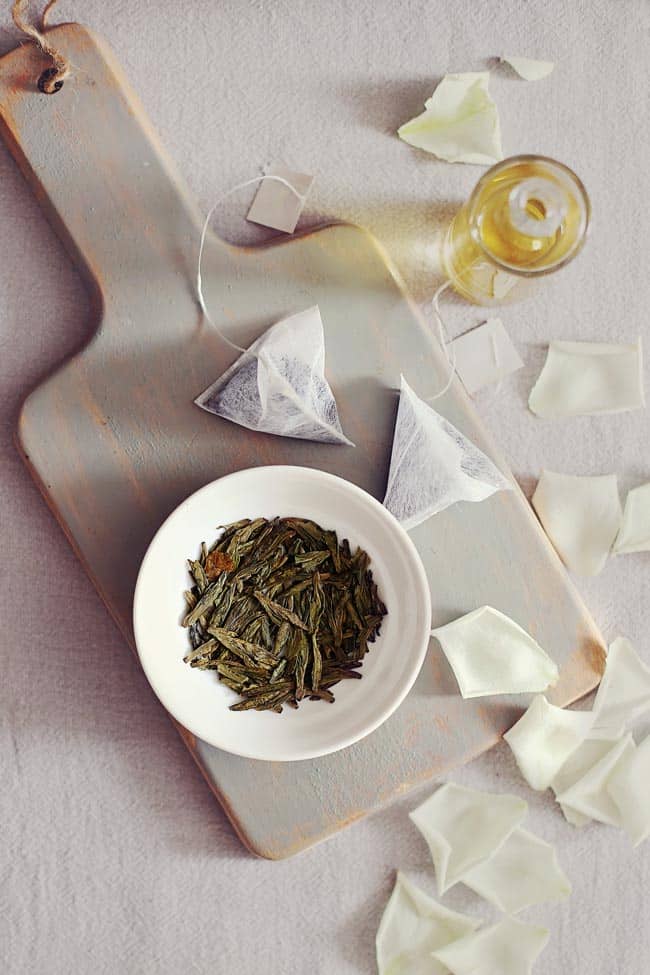
Green tea's powerful antioxidants have major beauty benefits, including:
- Reverses signs of aging — Green tea contains more polyphenols than black tea, providing its many well-known antioxidant and antiaging health benefits [source]. Drinking green tea and using it topically provides your skin with potent polyphenols that can help make your skin more resistant to sun damage and signs of aging [source].
- Evens out skin tone — Green tea's antioxidants help repair sun damage and promote a more even skin tone over time.
- Soothes irritated skin — Green tea is also an anti-inflammatory [source] that can help soothe sunburn, redness, and itchy skin.
- Reduces puffiness — Green tea contains caffeine, which helps relieve fluid buildup and puffy skin. Green tea's antioxidant content and mild vasoconstrictor effects can help reduce puffiness and dark circles when applied as an eye mask. Plus, it's a mild astringent that can help tone skin.
- Fights acne — Some research has indicated that when green tea is applied on the skin, its polyphenols can penetrate and lower sebum production, which is helpful for treating acne [source]. And its anti-inflammatory and antimicrobial properties soothe redness and inflammation.
1. Polishing Mask to Rejuvenate Dull Skin
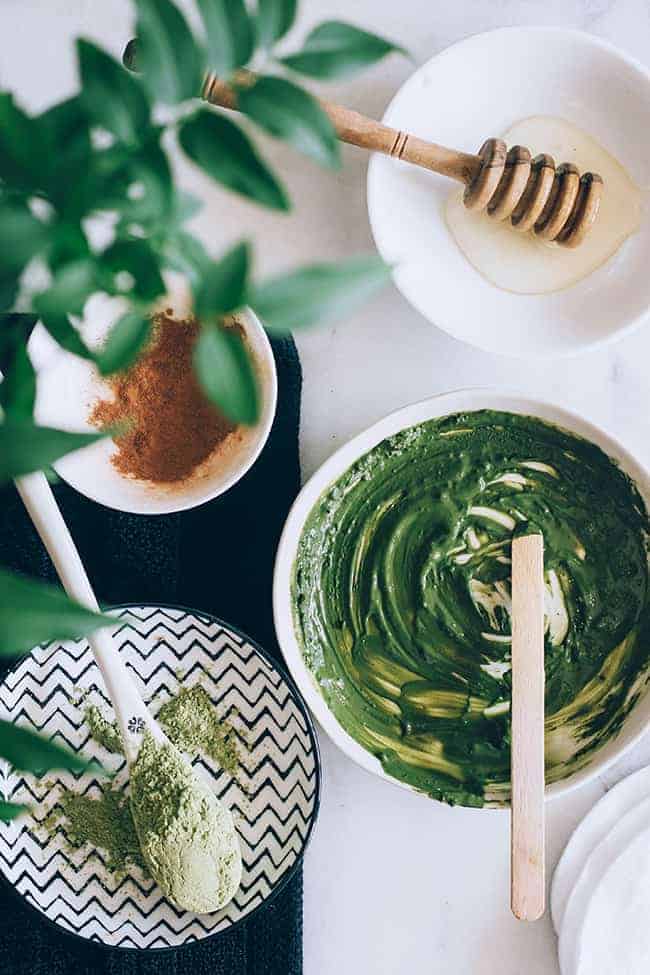
This facial mask combines the benefits of matcha with honey, boiled water, sandalwood essential oil, and a pinch of cinnamon, with its free-radical scavenging ability [source], to create a rejuvenating experience for the skin. One of the components of sandalwood, alpha-santalol, interferes with enzymes involved in the production of melanin [source].
—1 tablespoon matcha powder
—1 teaspoon honey
—½ tablespoon boiled water
—2 drops sandalwood essential oil
—Pinch of cinnamon (not suitable for sensitive skin types)
1. In a bowl, gradually add boiled water to the matcha green tea powder while stirring until you achieve a thick, applicable consistency.
2. Apply the mixture to your face and neck, avoiding the eye area.
3. Relax for 20 minutes while the mask works its magic. Rinse off the mask, tone your skin, and follow up with a moisturizer.
2. Antioxidant Mask to Plump Wrinkles
This matcha mask is packed with antioxidants to help smooth wrinkles and promote youthful-looking skin. Enriched with almond or rice milk, it can also help even out skin discoloration.
—1 teaspoon matcha powder
—2 teaspoons almond or rice milk
1. Mix the matcha and almond or rice milk together. Smooth the mixture onto your skin.
2. Relax for 10–20 minutes. Rinse off the mask and enjoy your rejuvenated skin.
3. Hydrating Mask for Dry Skin
Revitalize your skin and reveal a youthful glow with a avocado face mask, featuring the goodness of green tea powder and grapeseed oil. The rich nutrients and fatty acids in avocado provide nourishment for those parched skin cells [source].
—1 tablespoon green tea powder
—½ avocado
—1 tablespoon grapeseed oil
1. In a clean bowl, combine the green tea powder, mashed avocado, and grapeseed oil.
2. Mix well to create a smooth paste. Apply the mask to your face. Leave it on for 15 minutes.
5. Rinse off the mask and enjoy your refreshed complexion.
4. Herbal Steam to Boost Radiance
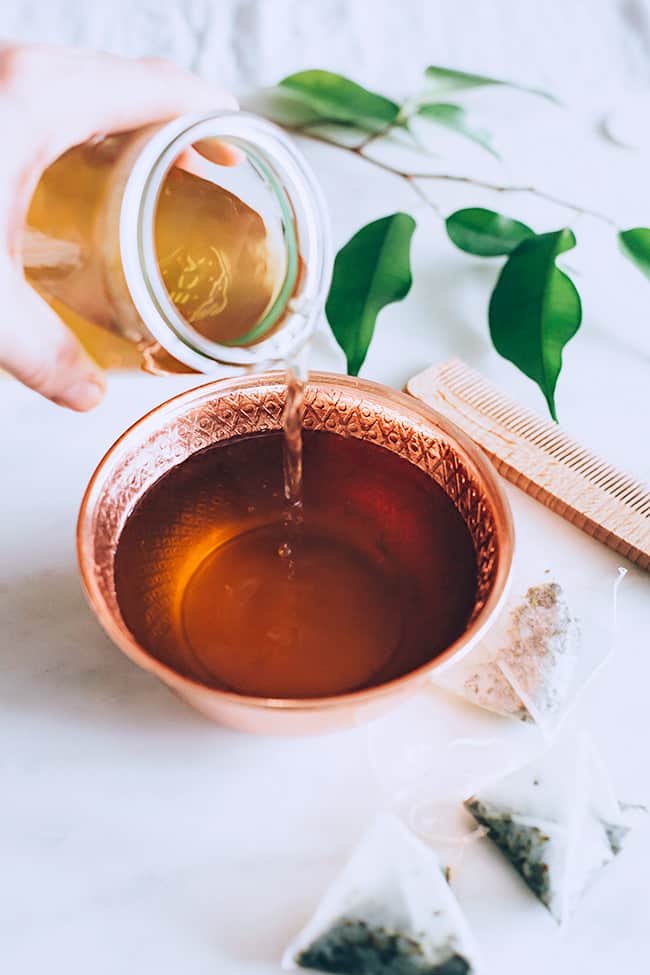
Elevate your skincare routine with a face steam featuring the combination of matcha and rosemary to boost circulation [source] and tone the skin.
—2 tablespoons matcha powder
—2 drops rosemary essential oil
—4 cups boiling water
1. Place the matcha and rosemary essential oil in a bowl.
2. Pour the boiling water over the mixture.
3. Lean over the bowl, covering your head with a towel to trap the steam.
4. Enjoy the facial steam for a few minutes to boost your skin's radiance.
5. Protection Mask to Prevent Sun Damage

Green tea polyphenols have been shown to protect the skin from the damaging effects of UV rays and reduce the risk of skin cancer [source]. And aloe vera reduces damage to the skin after sun exposure, but few people know that it also provides protection when used on the skin before you go out in the sun [source].
Indulge your skin in a rejuvenating and antiaging experience with this green tea, honey, and aloe vera gel face mask—before or after your beach day (and don’t forget sunscreen!).
—2 tablespoons brewed green tea
—1 tablespoon honey
—1 tablespoon aloe vera gel
1. Brew a cup of green tea and let it cool down.
2. In a clean bowl, combine the brewed green tea, honey, and aloe vera gel.
3. Mix the ingredients well until thoroughly combined.
4. Apply the mask evenly to your clean face, excluding the eye area.
5. Allow the mask to sit for approximately 15–20 minutes. Rinse off the mask using lukewarm water.
7. Gently pat your face dry with a clean towel, and follow up with your regular skincare routine.
6. Drawing Mask to Detox Skin
Clear your skin and reduce acne with this detoxifying face mask that combines bentonite clay and apple cider vinegar, two awesome acne fighters.
—1 tablespoon green tea powder
—1 tablespoon bentonite clay
—1 tablespoon apple cider vinegar
1. In a clean bowl, combine the green tea powder, bentonite clay, and apple cider vinegar.
2. Mix well until a smooth paste is formed.
3. Apply the mask evenly to your clean face, avoiding the eye area.
4. Leave the mask on for approximately 10–15 minutes or until it has dried.
5. Rinse off the mask with lukewarm water, gently massaging your skin in circular motions.
6. Pat your face dry with a clean towel, and continue with your regular skincare routine.
7. Energizing Mask to Shrink a Double Chin

Give your neck area some love with this matcha massage technique designed to help tighten and reduce a double chin.
—2 tablespoons matcha powder
—1 tablespoon water
—1 egg white
1. Mix the matcha powder, water, and egg white together.
2. Apply the mixture to your neck, using gentle pressure while gliding your hands downward.
3. Repeat the massage motion 3–4 times.
4. Rinse off the mixture after 15 minutes.
8. Spot Treatment to Fight Acne
Combat acne with this simple matcha spot treatment that combines the power of matcha powder and honey. Green tea helps regulate sebum production, and the antibacterial properties of honey help keep acne bacteria at bay [source].
—¼ teaspoon matcha powder
—½ teaspoon honey
1. Combine the ingredients and dab onto acne spots. Let it sit for 10–15 minutes, then rinse.
9. Mask to Even Out Skin Tone
Achieve a brighter and more even skin tone by combining green tea’s antioxidants with the skin-lightening power of curcumin [source] with a turmeric face mask.
—2 tablespoons brewed green tea
—½ teaspoon turmeric powder
—1 tablespoon honey
1. Brew a cup of green tea and let it cool down.
2. In a clean bowl, mix the brewed green tea, turmeric powder, and honey.
3. Stir the ingredients well until a smooth paste is formed.
4. Apply the mask evenly to your clean face, avoiding the eye area.
5. Leave the mask on for approximately 10–15 minutes.
6. Rinse off the mask with lukewarm water, gently massaging your skin in circular motions.
7. Pat your face dry with a clean towel, and continue with your regular skincare routine.
10. Exfoliating Mask To Brighten Skin
Gently polish dull skin with this nourishing and exfoliating mask that combines antioxidant green tea powder, healing honey, and yogurt to reveal brighter skin underneath. Yogurt contains lactic acid, an alpha-hydroxy acid with mild exfoliative properties that also moisturizes the skin [source].
—1 tablespoon green tea powder
—1 tablespoon honey
—1 tablespoon plain full-fat yogurt
1. In a clean bowl, combine the green tea powder, honey, and yogurt.
2. Mix well until a smooth paste is formed.
3. Apply the mask evenly to your clean face, avoiding the eye area.
4. Leave the mask on for approximately 15 minutes.
5. Rinse off the mask with lukewarm water, gently massaging your skin in circular motions.
6. Pat your face dry with a clean towel, and continue with your regular skincare routine.
11. Cooling Mask to Soothe Sunburn
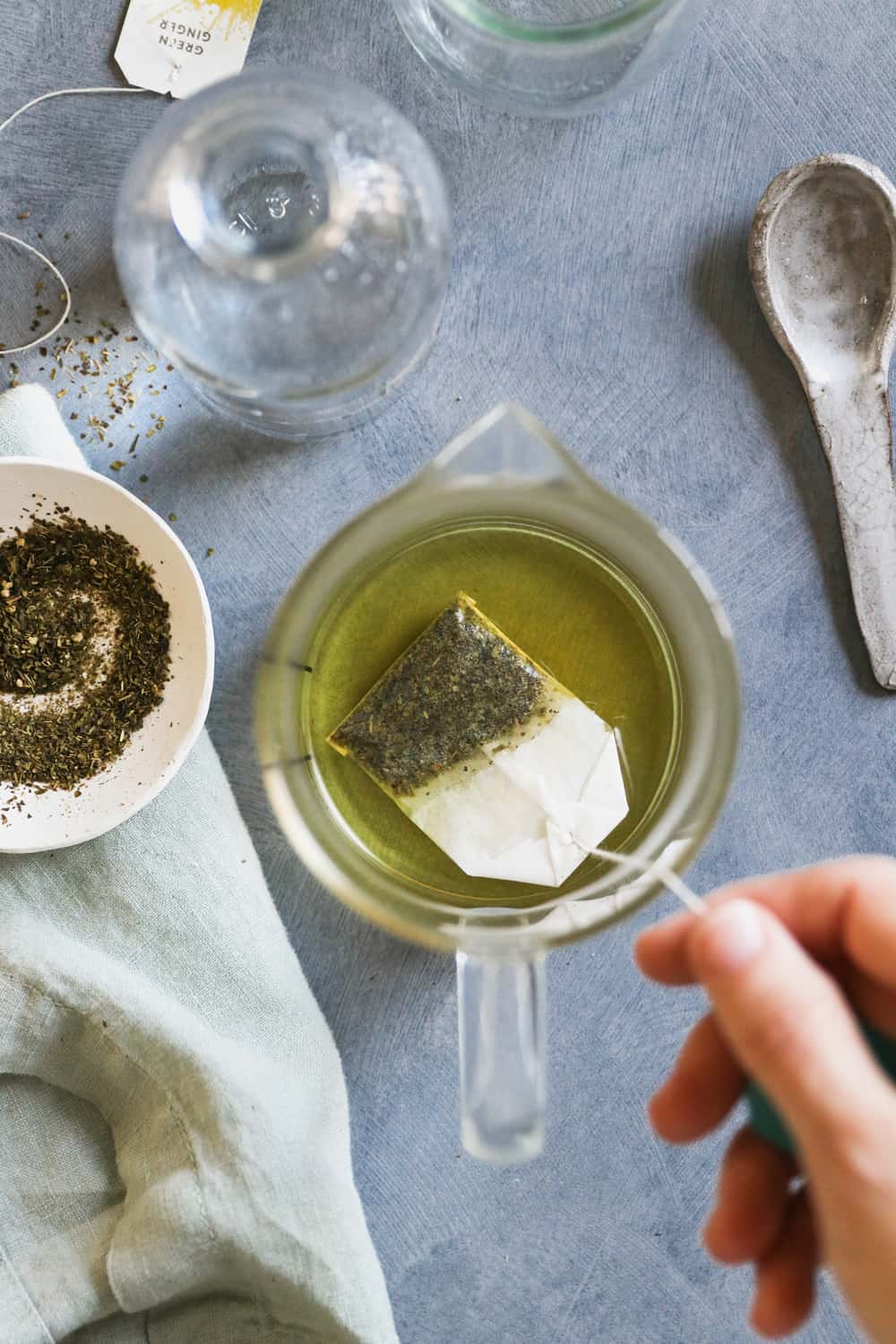
Soothe and repair sunburned skin with this hydrating and rejuvenating mask that combines brewed green tea, yogurt, and soothing aloe vera gel. Green tea’s polyphenols have been shown to reduce the number of cells affected by sunburn [source].
The beneficial bacteria in yogurt may help support a microbiome damaged by inflammation. And few things are better than the anti-inflammatory power of aloe to heal skin [source].
—2 tablespoons brewed green tea
—1 tablespoon plain full-fat yogurt
—1 tablespoon aloe vera gel
1. Brew a cup of green tea and let it cool down.
2. In a clean bowl, combine the brewed green tea, yogurt, and aloe vera gel.
3. Mix the ingredients well until thoroughly combined.
4. Apply the mask evenly to your clean face, avoiding the eye area.
5. Leave the mask on for approximately 15–20 minutes.
6. Rinse off the mask with lukewarm water.
7. Pat your face dry with a clean towel, and continue with your regular skincare routine.
12. Soothing Mask for Wind-Chapped Skin
Relieve wind-chapped skin with this calming mask that combines a finely ground oatmeal face mask with green tea to soothe irritation. Oatmeal is an anti-inflammatory that soothes irritated skin.
Like green tea, it contains polyphenols that actually inhibit enzymes in the inflammatory cascade and help to heal the skin barrier [source].
—2 tablespoons finely ground oats
—2 green tea bags steeped in 2 ounces of water
1. Combine the finely ground oats with the steeped green tea. Mix well until a smooth consistency is achieved.
2. Smooth the mixture over your skin, focusing on areas that are wind-chapped. Leave the mask on for approximately 10–15 minutes.
3. Rinse off the mask with lukewarm water. Pat your face dry with a clean towel, and continue with your regular skincare routine.
13. Calming Mask for Itchy Skin
Find relief for itchy skin with this soothing mask that combines brewed green tea, cooked oats, and honey. Research shows that phenol compounds in oatmeal called avenanthramides lower the release of histamine, which improves itching [source].
—2 tablespoons brewed green tea
—1 tablespoon cooked oats (they should be soft)
—1 tablespoon honey
1. Brew a cup of green tea and let it cool down.
2. In a clean bowl, mix the brewed green tea, cooked oats, and honey. Stir the ingredients well until a smooth paste is formed.
3. Apply the mask to your clean face, avoiding the eye area. Leave the mask on for approximately 15 minutes.
4. Rinse off the mask with lukewarm water, gently massaging your skin in circular motions to exfoliate. Pat your face dry with a clean towel, and continue with your regular skincare routine.
14. Ice Mask to Calm Sunburn
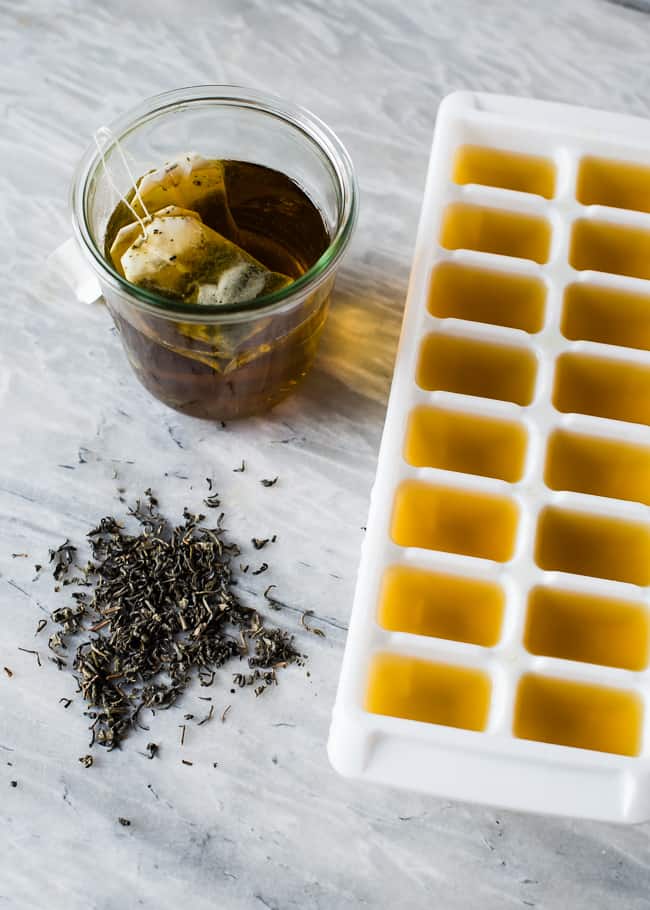
Alleviate the discomfort of sunburn with this cooling iced tea treatment.
—2 green tea bags
—2 cups of hot water
1. Steep the green tea bags in 2 cups of hot water. Allow the tea to cool.
2. Pour the tea into an ice cube tray and freeze.
2. Place some plastic wrap or a thin cloth over the sunburned areas, and rub the ice cubes over it (so the ice is not touching the skin directly).
15. Healing Compress to Combat Redness
Reduce redness with this simple green tea compress that combines the skin-cooling effects of green tea with the anti-inflammatory and healing properties of honey [source].
—2 green tea bags steeped in 2 cups of water
—1 teaspoon honey
1. Steep the green tea bags in 2 cups of water. Let cool then add honey to the mixture and mix well.
2. Saturate a washcloth with the solution. Place the dampened washcloth on your face for 10 minutes.
3. You don’t need to rinse this mask off. Just apply moisturizer when you are finished.
Top tip
Don't want to DIY? Try these options instead:
Biorepublic Green Tea Detox Purifying Mask // Although meant for one-time use, you can stock up on these masks to use on the regular. “This sheet mask provides a boost of antioxidants and helps remove excess sebum while also reducing the appearance of blemishes and imperfections,” shares Marisa Garshick, M.D., a dermatologist at Medical Dermatology & Cosmetic Surgery (MDCS) in New York.
Bliss Green Tea Wonder Clarifying Overnight Gel Mask // This clarifying mask contains a blend of azelaic acid, green tea extract, and fermented green tea oil, which works to help absorb excess oil, explains Dr. Garshick. It also contains aloe to help soothe the skin while also delivering hydration. And it smells incredible, too—thanks to a botanical blend of fragrances, including rosemary and eucalyptus extracts.
FAQ
Yes, you can use various types of green tea for face masks, including loose leaf green tea, green tea bags, or matcha green tea powder. However, using organic and high-quality green tea will yield the best results.
Using a green tea face mask 2 to 3 times a week can help maintain healthy skin and address specific concerns effectively.
For most green tea face masks, leaving them on for 10 to 15 minutes should be sufficient to allow the active ingredients to work effectively.
It's best to use freshly prepared green tea face masks for maximum potency and efficacy.
This post was medically reviewed by Dr. Jennifer Haley, a board-certified dermatologist with extensive experience in medical, cosmetic, and surgical dermatology. Learn more about Hello Glow’s medical reviewers here. As always, this is not personal medical advice, and we recommend that you talk with your doctor.
References
- Fertilizer for the face? The New York Times website.
- OyetakinWhite P, et al. Protective mechanisms of green tea polyphenols in skin. Oxid Med Cell Longev. 2012.
- Chacko SM, et al. Beneficial effects of green tea: a literature review. Chin Med. 2010.
- Moy RL, et al. Sandalwood album oil as a botanical therapeutic in dermatology. J Clin Aesthet Dermatol. 2017.
- Ranasinghe P, et al. Medicinal properties of ‘true’ cinnamon (Cinnamomum zeylanicum): a systematic review. BMC Complement Altern Med. 2013.
- Flores M, et al. Avocado oil: characteristics, properties, and applications. Molecules. 2019.
- Zink A, et al. Green tea in dermatology—myths and facts. J Dtsch Dermatol Ges. 2015.
- Korać RR, et al. Potential of herbs in skin protection from ultraviolet radiation. Pharmacogn Rev. 2011.
- Saric S, et al. Green tea and other tea polyphenols: effects on sebum production and acne vulgaris. Antioxidants. 2016.
- McLoone P, et al. Honey: a therapeutic agent for disorders of the skin. Cent Asian J Glob Health. 2016.
- González-Minero FJ, et al. Rosmarinus officinalis L. (rosemary): an ancient plant with uses in personal healthcare and cosmetics. Cosmetics. 2020.
- Hollinger JC, et al. Are natural ingredients effective in the management of hyperpigmentation? A systematic review. J Clin Aesthet Dermatol. 2018.
- Tang SC, et al. Dual effects of alpha-hydroxy acids on the skin. Molecules. 2018.
- Yusuf N, et al. Photoprotective effects of green tea polyphenols. Photodermatol Photoimmunol Photomed. 2007.
- Hekmatpou D, et al. The effect of aloe vera clinical trials on prevention and healing of skin wound: a systematic review. Iran J Med. Sci. 2019.
- Pazyar N, et al. Oatmeal in dermatology: a brief review. Ind J Dermatol Vener Leprol. 2012.

